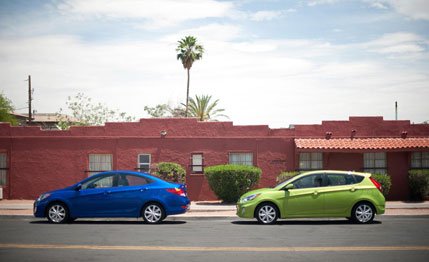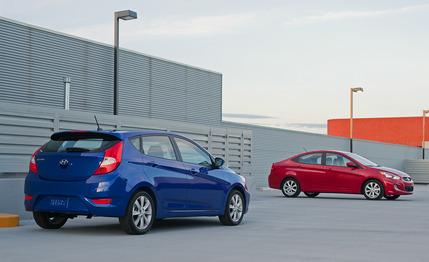
 First Drive Review
First Drive Review
We’re getting used to the idea of desirable small cars, but the notion of a desirable Hyundai still feels crisp and fresh. (The 2011 Sonata was the first Hyundai ever to land on our 10Best Cars list.) The latest creation churned out of the invigorated Korean company is a car hoping to marry these two novel desirabilities. The Accent, stylistically, is an evolution of the corporate countenance that debuted on the Sonata, although it looks less “faces of Volkswagen CC” on this smaller package.
As it was in its previous generation, the Accent will be available as a four-door sedan or with an odd number of doors. This time around, the latter goes from three-door hatch to five-door hatch/wagon. (The five-door, as is the case with most compacts today, looks better than the sedan.) In a role reversal, the sedan is now the cheaper of the two body styles, with the wagon being between $600 and $2150 dearer than the four-door, based on trim. Overall length now stands at 172.0 inches for the sedan and 162.0 for the wagon. Both ride on a 101.2-inch wheelbase, which is 2.8 inches longer than the outgoing models’. Width is up 0.2 inch, to 66.9. (Equally important is the platform’s 22-percent increase in rigidity compared with its predecessor.)
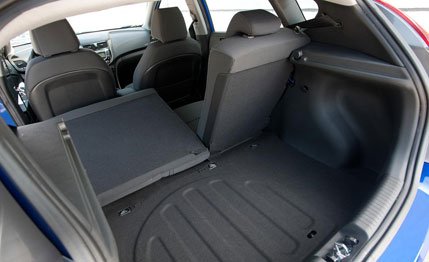

The standard height-adjustable driver’s seat means that even fugitive circus freaks will be comfortable upfront. Although the 0.6 inch the sedan’s back-seat passengers sacrifice in headroom doesn’t have a meaningful impact on interior-volume calculations, it’s a critical loss for taller riders. Another reason to favor the hatch is cargo volume. It can accommodate 21 cubic feet behind its rear seat, compared with 14 swallowed by the sedan’s trunk. Hyundai says that 14 cubic feet are enough for four sets of golf clubs; that might be the case only if they’re loose. The sedan’s rear seatback folds in a 60/40 split to accommodate longer items, but you can haul 48 cubic feet if you drop the rear seats in the wagon.
Who Stole My Sorority Letters?
Under the hood lives a new 1.6-liter four-cylinder—dubbed Gamma, in Hyundai’s books— that will also see duty beneath the bonnet of the upcoming Veloster. An aluminum block helps the new engine undercut its predecessor’s weight by 40 pounds. With variable timing on the intake and exhaust camshafts and direct injection, the four makes 138 hp and 123 lb-ft of torque, both figures handily outranking those of most of its competitors. The Honda Fit musters 117 hp, the Ford Fiesta 120, the new Nissan Versa 109, and the featherweight Mazda 2 a piddling 100. (Only the 2012 Chevrolet Sonic can compare, getting 138 hp from either of its engines.) At an estimated 2450 to 2650 pounds, the Accent line doesn’t have to lug around much (if any) more weight than that crowd. Power flows through an automatic or manual transmission—both with six speeds—to the front wheels. The automatic comes with hill-start assist to prevent it from rolling backward when stopped, a feature far more useful with manuals but not offered on the stick-shift Accent.
On our brief drive, we didn’t get a chance to sample the automatic transmission but found the manual to be halfway satisfying. The shifter is light and crisp with appreciably brief throws, but the clutch is a disappointment. It offers nearly zero feel—although it isn’t as empty and soulless as a Toyota clutch—and uses only the top two or three inches of its long travel. Still, Hyundai claims that about 20 percent of Accent buyers opt to row their own. They might not be kicking the most rewarding clutch in the business, but we tip our hats to those customers nonetheless. Cars with either transmission get an eco mode, which alters the shift points in the automatic; manual drivers get an arrow in the IP that prompts them to upshift entirely too early.
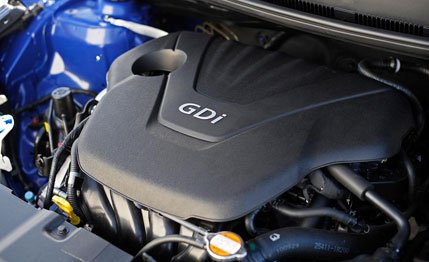

Hyundai touts the Accent’s class-leading power-to-weight ratio, but the engine doesn’t quite have the effect we hoped for. Like almost all similarly diminutive engines, the 1.6 doesn’t do much until higher rpm. Power builds smoothly, though, and the engine sounds happy enough being wound out. The Accent achieves EPA fuel-economy numbers of 30 mpg city and 40 highway regardless of transmission choice, although the manual gets 1 more mpg in the EPA’s combined test: 34 versus 33. Hyundai says the car should need 9.4 seconds to get to 60 mph with a manual and 9.8 with an automatic. We can neither confirm nor deny this, as we started to nod off at 49 mph, but we estimate the cars will be slightly quicker, at 8.0 and 8.3 seconds. Cars in this class aren’t meant to be rocket sleds, of course, and the Accent will be sufficiently peppy for most buyers. But its pace is a reminder that it is, in fact, an economy car.
Pretty on the Inside
Drivers might need that reminder, as this doesn’t feel like an economy car on the inside. Its interior is typical of Hyundai’s current cars, with ritzy materials throughout. The satin silver and piano black on top-level models are stylish enough to make the inside of a Dumpster feel cosmopolitan. Note that we are not calling the Accent a Dumpster; even in lower trim levels unavailable with the silver-and-black combo, upmarket materials and thoughtful design make the car feel much richer than its low price tag might suggest.
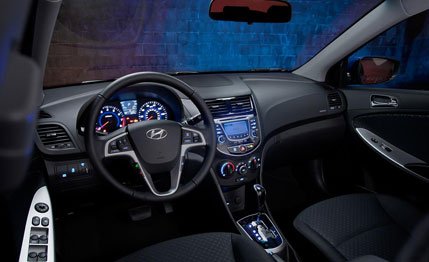

The seats are quite comfortable, with soft bolsters that are so nonintrusive we didn’t realize they were there until we felt ourselves leaning on them in corners. Then again, the lateral demands placed on the bolsters will never be very high. With MacPherson struts upfront and a torsion-beam suspension at the rear, the Accent is competent and smooth, but almost to a fault. Although it is wonderfully relaxed on the highway, the spongy springs struggle to control body motions. During aggressive cornering, body movements seem to boss the torsion beam around, compromising path control. Hyundai, however, probably wouldn’t try to tell you that this is an economy car for the enthusiast. The Accent is a serene and relaxed form of affordable transportation. Leave the sportiness to the Honda Fit—or a used GTI.
Warning: Long Lists Ahead
From an equipment standpoint, Hyundai is leaving almost nothing to its competitors. The list of standard and optional gear reads as though product planners went through similar documents for every single competitor and said yes to everything. Standard stuff on the $13,205 base GLS sedan includes adjustable active front headrests; four-wheel disc brakes; a tilting steering wheel; a six-way-adjustable driver’s seat; power locks; and front, front side, and two-row curtain airbags. The automatic transmission comes as part of a $2750 upgrade that includes air conditioning, power windows and mirrors, and an uplevel stereo with six speakers, a CD player, satellite radio, and USB and auxiliary input jacks. Minus the automatic, all of that can be added to the manual car for $1750.
The five-door starts with the $15,355 GS trim, which includes everything from the basic sedan plus the upgraded stereo; power windows, mirrors, and locks; and keyless entry. An automatic is a $1200 option on the GS hatch and also nabs cruise control. At the top of the pyramid is the SE wagon, which adds cruise control, steering-wheel-mounted audio controls, Bluetooth, a leather-wrapped steering wheel and shift knob, the stylish piano-black interior accents, 16-inch aluminum wheels, and a rear spoiler. The automatic is a $1000 stand-alone option on the SE.
Although our perfect compact car would be a bit stiffer and more responsive, the new Accent should leave its buyers wanting for very little. It’s attractive—and we appreciate the deep blue, vibrant red, metallic brown, and electric-green paint options—well equipped, and among the most affordable new cars on the market today. In other words, it’s yet another desirable small car, and yet another desirable Hyundai.
